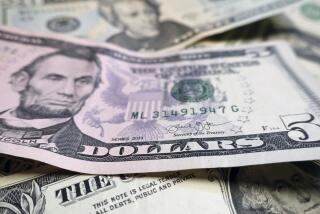CURRENCY : Dollar Hits Record Low Against Yen in N.Y.
- Share via
NEW YORK — The dollar plunged along with stocks and bonds Wednesday as bearish sentiment overwhelmed the government’s report of a narrowing of the U.S. merchandise trade deficit.
“The trade numbers weren’t really that bad, but the market sentiment was to push the dollar down no matter what,” said Bill Hand, a currency trader at First Pennsylvania Bank in Philadelphia.
The dollar registered its lowest close against the Japanese yen in New York trading since modern exchange rates were established in the late 1940s, falling nearly 1% to 122.24 yen. The dollar closed lower once in Tokyo, on Jan. 4 of this year, when it finished at 121.65.
In early trading today, the dollar slid to its lowest opening level this year against the Japanese yen despite reported central bank intervention. The dollar opened trading at 122.40 yen, down from Wednesday’s close of 123.54 yen. It was the dollar’s lowest opening since Jan. 4, the first trading day of 1988, when it began trading at 120.45 yen.
The dollar also fell 1.5% against the West German mark, 1.4% against the British pound, 1.3% against the French franc and 1.4% against the Swiss franc. It reached nearly six-month lows against some European currencies.
The Commerce Department reported early Wednesday that the trade deficit narrowed to $10.5 billion in September, which was roughly in line with expectations of $9 billion to $11 billion.
Stocks, Bonds Hurt
Traders’ immediate reaction was to send the dollar and bonds higher. But the underlying bearish sentiment soon took hold and the dollar edged downward throughout the day.
Traders selling dollars defied two reported attempts by the Federal Reserve to stabilize the currency through dollar purchases.
The dollar’s decline hurt stocks and bonds, and in turn the weakness in those markets helped send the dollar lower, said Philip Eriksen, a senior vice president at Wells Fargo Bank in San Francisco.
“This is the first time we’ve seen the bond market, the stock market and the foreign exchange market all going down at the same time. They’re all focusing on each other,” Eriksen said.
The Dow Jones index of 30 industrials dropped 38.59 to 2,038.58, its lowest close since it stood at 2,002.31 on Sept. 1.
In the bond market, the yield of the benchmark 30-year Treasury bond jumped to 9.11% in late trading from 9.01% late Tuesday.
Bond yields rise when prices fall and are a good indicator of overall interest rate trends.
The trade report showed a record level of U.S. exports and a 2.5% decline in imports from the August record. But the deficit’s decline was not enough to comfort traders who have shown increasing concerns about the federal budget deficit and the U.S. dependence on inflows of foreign capital.
“In many respects, this is one of the least important trade numbers we’ve seen in a long time,” said Stephen Leach, a currency analyst at Chemical Bank.
Remarks by Federal Reserve Board Chairman Alan Greenspan were also interpreted negatively for the dollar, dealers said.
Answering questions before the U.S. National Economic Commission, Greenspan said the United States cannot grow out of its budget deficit.
Greenspan said the financial markets appear to be waiting for firm deficit reduction proposals from Congress.
In Tokyo, where trading ended before the trade number was released, the dollar rose 0.29 yen to a closing 123.54 yen.
Later in London, it was quoted at 123.40 yen. In New York, the dollar sank to 122.24 yen from 123.23 yen late Tuesday.
In London, the dollar fell against the British pound, which rose to $1.8225 from $1.8060 late Tuesday. The dollar also fell in New York against the pound, which rose to $1.8338 from $1.8083.
Other late dollar rates in New York, compared to late rates Tuesday, included: 1.7164 West German marks, down from 1.7433; 1.4422 Swiss francs, down from 1.4626; 1.2296 Canadian dollars, down from 1.2337; 5.8770 French francs, down from 5.9535, and 1,277.75 Italian lire, down from 1,297.00.
Other late dollar rates in Europe, compared to late rates Tuesday, included: 1.7230 West German marks, down from 1.7465; 1.4465 Swiss francs, down from 1.4630; 5.8975 French francs, down from 5.9660; 1.9575 Dutch guilders, up from 1.9685; 1,291.00 Italian lire, down from 1,300.50, and 1.2305 Canadian dollars, down from 1.2344.
Gold prices rose in most markets.
At the start of the trading day in Hong Kong, gold fell 38 cents an ounce to close at a bid of $423.69.
On the Commodity Exchange in New York, gold bullion for current delivery rose to $424.50 from $424.40.
Tables, Page 12
More to Read
Inside the business of entertainment
The Wide Shot brings you news, analysis and insights on everything from streaming wars to production — and what it all means for the future.
You may occasionally receive promotional content from the Los Angeles Times.










